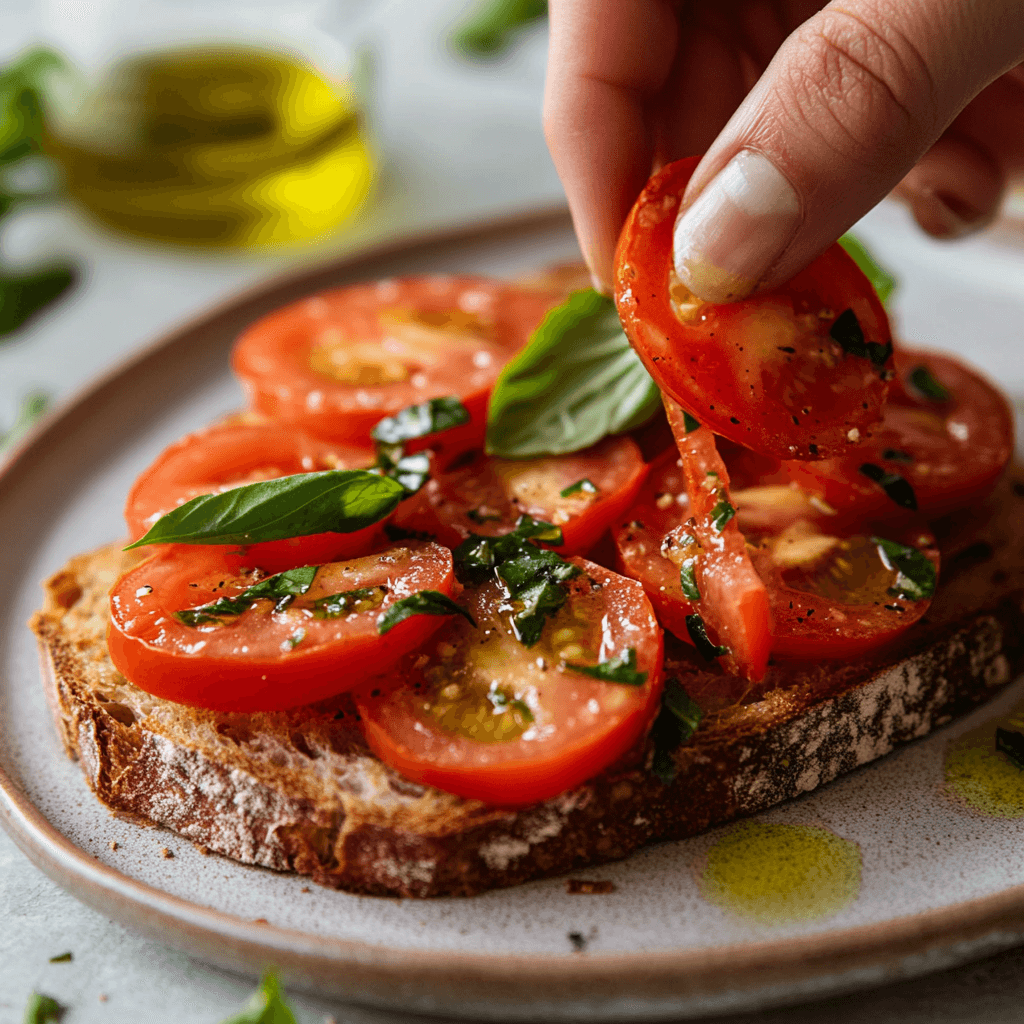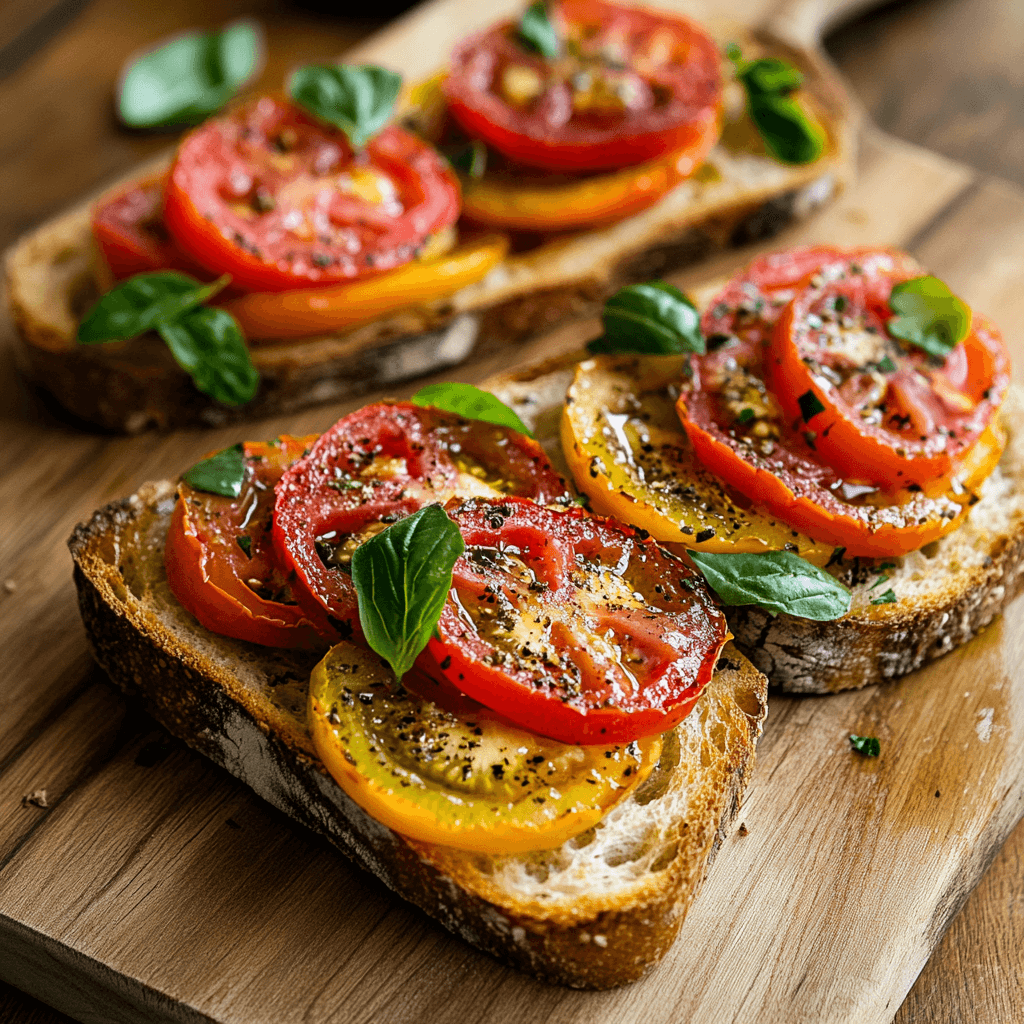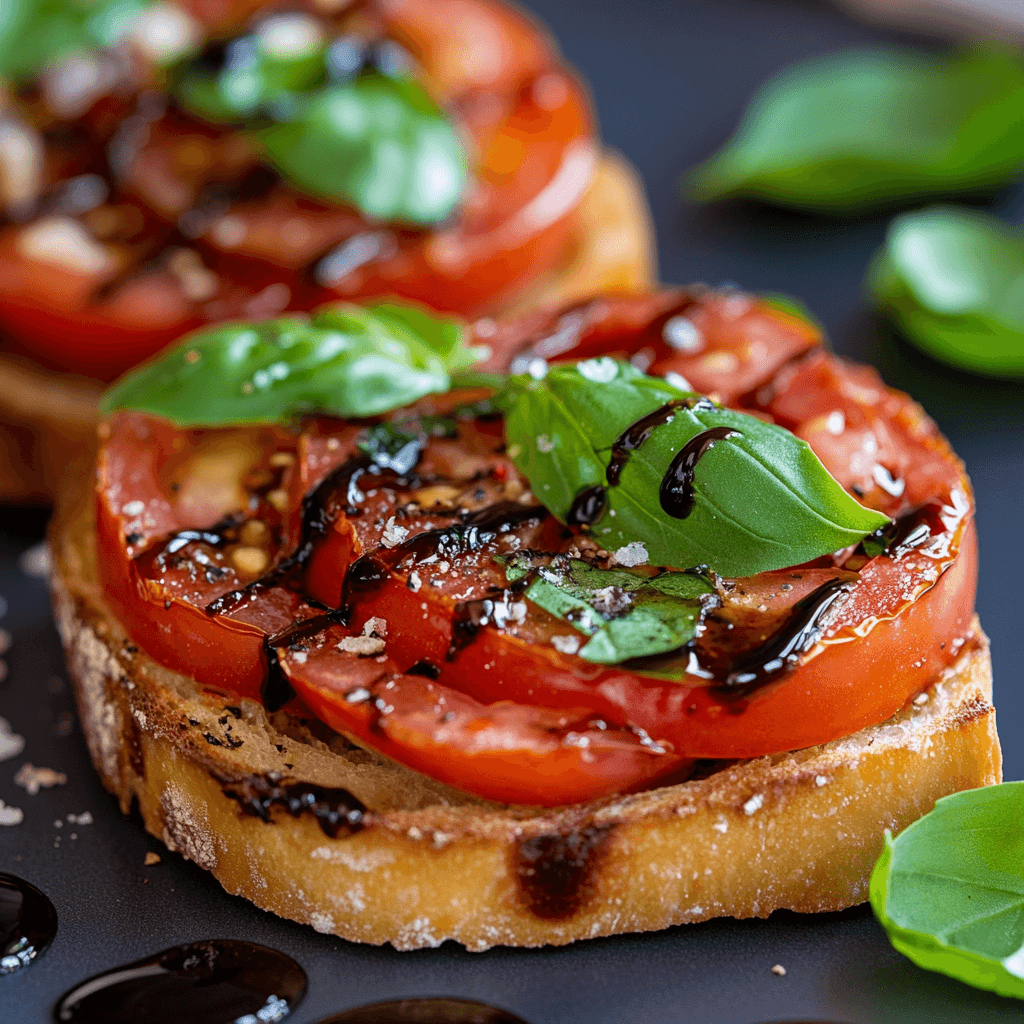Tomato tartine, a delightful open-faced sandwich, marries the simplicity of rustic French cuisine with the freshness of garden ingredients. Each bite reveals a perfect harmony of flavors that elevates the humble tomato to gourmet status. This article delves into the essence of a tomato tartine. You’ll explore its contrasts with bruschetta, understand why Italian tomatoes taste superb, and discover a delicious recipe you can effortlessly master. With vibrant tomatoes and quality olive oil, this dish transforms into an experience that captivates and nourishes. Whether you make it for breakfast, lunch, or dinner, your family and friends will be impressed.

The Ultimate Tomato Tartine
Ingredients
Method
- Toast the Bread: Lightly toast the slices of bread in a toaster or on a skillet until golden and crispy. Ensure the bread is still soft inside and has a nice crunch on the outside.
- Spread Pesto (Optional): If you're using pesto, spread a thin layer on each slice of toasted bread. This adds extra flavor to the tartine.
- Arrange the Tomato Slices: Layer the thin slices of ripe tomatoes evenly over the bread. Make sure the slices cover the bread fully, creating a colorful and fresh base for your tartine.
- Season with Salt and Pepper: Sprinkle Maldon or fleur de sel over the tomatoes to bring out their natural sweetness. Add freshly ground black pepper and, for some heat, red pepper flakes if desired.
- Drizzle Olive Oil: Drizzle a generous amount of extra virgin olive oil over the tomatoes and bread for a rich texture and enhanced flavor.
- Serve: Serve the tartines immediately while the bread is still warm and crispy. Enjoy as a light lunch or appetizer!
Notes
- Vegan Option: To make this dish vegan, simply skip the pesto if it contains dairy or use a dairy-free pesto alternative.
- Gluten-Free Option: For a gluten-free version, use gluten-free bread.
- Variations: You can add fresh basil leaves or a drizzle of balsamic glaze for extra flavor.
What Is a Tomato Tartine?
How is a Tomato Tartine Different from Bruschetta?
To appreciate a tomato tartine, it is important first to understand how it differs from bruschetta. Both dishes celebrate the delicious partnership of bread and tomatoes, yet they originate from distinct culinary traditions. A classic tomato tartine finds its roots in French cuisine, featuring a slice of rustic bread, usually topped with fresh ingredients, which can include tomatoes, herbs, and sometimes cheese.
Bruschetta, on the other hand, is an Italian appetizer characterized by grilled or toasted bread, typically rubbed with garlic and adorned with diced tomatoes, basil, and a drizzle of olive oil. Although often used interchangeably in conversation, these appetizers have distinct preparation methods and cultural significance. For example, bruschetta is generally served as a starter, while a tartine can be enjoyed at any meal or even as a light snack.
To truly appreciate this culinary distinction, consider the preparation methods. Bruschetta requires toasted bread, while a tartine can utilize either toasted or fresh bread, allowing more flexibility. This makes the tomato tartine exceptionally versatile, allowing variations that can cater to different taste preferences.
Understanding the French Tartine
A French tartine is essentially a blank canvas for culinary creativity. Traditionally, it starts with a slice of hearty, crusty bread. The toppings can be as varied as your imagination allows. Common additions include fresh vegetables, spreads, cheeses, or even meats that complement the bread’s flavor and texture.
What makes a tartine special is its simplicity; it lets the fresh ingredients shine through without overwhelming flavors. Additionally, a well-prepared tartine relies heavily on the quality of its components. Fresh basil, for instance, can add a fragrant layer of flavor that perfectly complements ripe tomatoes.
Moreover, the flexibility of a tarine makes it a favorite for many cooks, inviting seasonal variations. For instance, in summer, top it with heirloom tomatoes, fresh mozzarella, and basil to create a refreshing dish. In the fall, you might use roasted squash alongside ricotta or feta. This adaptability to seasonal ingredients keeps each tartine exciting.
Why Do Italian Tomatoes Taste So Good?
The Secrets Behind Italian Tomato Flavor
One significant factor that sets Italian tomatoes apart is the exceptional flavor and sweetness they deliver. Various elements contribute to this culinary gem, providing insight into why you should seek out these tomatoes for your dishes. The climate in Italy, particularly regions such as Campania and San Marzano, is characterized by warm sunlight and fertile volcanic soil. These conditions allow tomatoes to reach their full potential, ripening beautifully on the vine.
Another reason Italian tomatoes taste fantastic is the agricultural practices used. Many Italian growers prioritize the authentic flavor over mass production. They cultivate heirloom varieties that are known for their rich taste and unique characteristics. For instance, San Marzano tomatoes, often regarded as the best in the world, are cherished for their sweet flavor and low acidity, making them perfect for sauces and fresh applications.
Additionally, the cultural importance of tomatoes in Italian cooking cannot be overstated. They are not just ingredients; they are a staple that carries generations of tradition and culinary knowledge. Using high-quality, fresh tomatoes elevates a simple dish like tomato tartine into something extraordinary, allowing the flavors to speak for themselves.
If you’re eager to explore this further, you might find it enlightening to read about Italian tomatoes, which not only underscore their role in Italian cuisine but also highlight their impact on various global dishes.
How to Make the Best Tomato Bruschetta
Easy Steps for Delicious Tomato Bruschetta
While preparing a tomato tartine is straightforward, mastering tomato bruschetta can enhance your culinary repertoire. Bruschetta provides a wonderful platform to highlight fresh flavors and showcase the quality of your ingredients.
- Select the Right Bread: Start with a high-quality loaf of rustic bread, such as sourdough or a fresh baguette. Graduation in texture is essential; the bread should be sturdy enough to hold the toppings without falling apart.
Prepare the Tomatoes: Select ripe, juicy tomatoes, which are essential for depth of flavor. Dice them finely, and then place them in a mixing bowl. Add fresh, finely chopped basil, a drizzle of olive oil, and season with salt and pepper. Allow this mixture to sit for about 15 minutes—a step that enhances the melding of flavors. This waiting period is crucial; it allows the juices from the tomatoes to blend with the olive oil and seasonings, creating a delicious topping.
Toast the Bread: Preheat your oven to 400°F (200°C) before slicing the bread into thick pieces. Place these on a baking sheet, and drizzle with olive oil to toast. Bake for about 10 minutes, until each slice is golden and crispy. This texture is essential for providing a satisfying crunch against the juicy topping.
Assemble the Bruschetta: As soon as the bread is ready, remove it from the oven and let it cool slightly. Spoon generous dollops of the tomato mixture onto each slice just before serving. This ensures that the bread retains its crispiness. Optionally, you can drizzle some balsamic glaze over the top for an extra layer of flavor.
Enjoy Immediately: The key to enjoying bruschetta is to eat it fresh. The combination of crispy bread and juicy tomatoes offers a delightful contrast that makes every bite memorable.

Ingredients and Instructions
When preparing a tomato tartine, the quality of your ingredients is paramount. Here’s what you’ll need to create this Amazing dish:
| Ingredient | Amount | Notes |
|---|---|---|
| Fresh Tomatoes | 2 cups | Ripe, ideally heirloom |
| Olive Oil | 1/4 cup | Opt for extra virgin |
| Crusty Bread | 4 slices | Use rustic country bread |
| Garlic | 2 cloves | For rubbing on bread |
| Fresh Basil | 1/4 cup | Chopped, garnish optional |
| Salt and Pepper | To taste | Important for seasoning |
Table of Contents
Instructions for Making Tomato Tartine
- Choose Your Bread: Start with high-quality, rustic bread like sourdough or a hearty baguette. Ensure the bread is thick enough to support the toppings without becoming soggy.
Prepare the Tomatoes: Slice the fresh tomatoes and arrange them generously on the toasted bread. Selecting juicy, ripe tomatoes is crucial; their flavor will define your tartine.
Drizzle with Olive Oil: After layering your tomatoes, generously drizzle them with quality extra virgin olive oil. This step does not just add richness but also enhances the overall flavor of your dish.
Seasoning is Key: Sprinkle salt and freshly cracked pepper over the tomatoes. Careful seasoning enhances the natural flavors of the ingredients, making each bite burst with taste.
Add Aromatics: For an added layer of flavor, rub a clove of garlic onto the toasted bread. This step infuses the bread with garlic aroma without overpowering the dish.
Final Touches: Top with freshly chopped basil or any other preferred garnishes, such as crumbled feta cheese or a drizzle of balsamic vinegar. This not only enhances presentation but adds exciting flavor contrasts.

Innovations and Variations
While the recipe above outlines a classic interpretation, don’t hesitate to experiment with creative variations. The tomato tartine is a versatile foundation just waiting for you to add your flair.
For instance, you might incorporate a variety of toppings. Consider:
- Cheese Additions: Adding slices of fresh mozzarella or tangy goat cheese can deepen the flavor of the dish significantly. The creaminess of the cheese complements the vibrant tomatoes beautifully.
Vegetable Layering: Herbs and vegetables offer freshness and crunch. Top with slices of avocado, roasted red peppers, or even a handful of freakishly fresh arugula for added texture and flavor.
Protein Choices: Adding proteins like thinly sliced smoked salmon or prosciutto can elevate your tartine to an elegant brunch item. Any protein choice you make should enhance the overall flavor without overshadowing the tomatoes.
With a bit of imagination, you can craft a tomato tartine that reflects your personal taste while keeping it simple and attractive. The possibilities are endless—so unleash your creativity!

This engaging overview of tomato tartines serves as a springboard for your culinary adventures. Whether you choose to stick to the classic or experiment with exciting toppings, the joy of creating your version lies at the heart of this exquisite dish. As we move forward, we’ll explore common mistakes to avoid while preparing a perfect tomato tartine, alongside tips to enhance your tartine-making skills further.
markdown.
Common Mistakes When Making Tomato Tartine
Avoid These Tomato Tartine Pitfalls
When preparing a tomato tartine, avoiding certain common mistakes is essential. Below, I’ll detail these potential pitfalls and provide insight into how to keep your tartine delicious and visually appealing.
- Using Unripe Tomatoes:
- Importance of Ripe Variety: Choosing ripe tomatoes is imperative for achieving the best flavor in your tartine. Unripe tomatoes often lack the balance of sweetness and acidity that makes the dish delightful. Opt for varieties like San Marzano or vine-ripened tomatoes, which are renowned for their exceptional flavor.
- Test for Ripeness: To determine ripeness, gently squeeze the tomato. A ripe tomato should yield slightly to pressure. Additionally, smell the tomato; it should have an aromatic scent that hints at its flavor.
- Ignoring Seasoning:
- Significance of Adequate Seasoning: Seasoning enhances the flavors of every ingredient. Underscoring the importance of salt, a sprinkle can elevate the sweetness of the tomatoes, while fresh cracked black pepper can add a bit of kick.
- Seasoning Tips: Consider using sea salt or flaky salt for a gourmet touch. Moreover, adding fresh herbs like basil or thyme not only enhances flavor but also adds beautiful color to the dish.
- Overcomplicating the Toppings:
- Simplicity is Key: The beauty of a tomato tartine lies in its simplicity. While it might be tempting to pile on various toppings, remember that too many flavors can overwhelm the dish. Stick to a few high-quality ingredients that complement each other well.
- Best Practices: Focus on highlighting fresh tomatoes and a drizzle of olive oil as your primary toppings. These key elements can stand alone beautifully without added complexity.
- Not Toasting the Bread Properly:
- Creating the Right Texture: The bread should be toasted to a perfect golden brown. Under-toasted bread may not provide the necessary crunch and could absorb too much moisture, resulting in a soggy tartine.
- Toasting Technique: Toast your bread until it is firm and crisp, as this will act as a solid base for your toppings. You can achieve even toasting by using a broiler or a grill; both methods impart a lovely charred flavor.
- Forgetting About Fresh Herbs:
- Elevating the Flavor Profile: Fresh herbs add a burst of flavor and brightness to your dish. Skipping herbs like basil can diminish the overall impact.
- Herb Usage: Once the tartine is assembled, garnish with freshly chopped basil or even arugula for an added layer of flavor. This not only makes the tartine more aromatic but also visually appealing.
- Serving Immediately:
- Timing Matters: Waiting too long between assembling your tartine and serving it can result in a soggy mess. Bread can absorb moisture from the toppings, compromising the texture.
- Quick Assembly Advice: Assemble your tartines right before serving. This ensures your guests experience that enjoyable crunch, creating an exceptional flavor contrast with the juicy tomatoes.
By being mindful of these common mistakes, you can create a tomato tartine that is truly remarkable each time you prepare it.
Pro Tips & Variations
Enhance Your Tomato Tartine Experience
After mastering the construction of your tomato tartine and avoiding the pitfalls, you now have the opportunity to elevate your dish through exciting variations and pro tips:
- Experiment with Different Breads:
- Bread Selection: The type of bread you choose can dramatically change your tartine experience. Besides the classic country loaf, consider using ciabatta, which offers a chewy texture and airy crumb, or even bagels for a unique twist.
- Personalized Touches: For a gluten-free option, grilled polenta or gluten-free artisan bread can subtley mimic the crusty base while catering to dietary needs.
- Try Seasonal Variants:
- Topping Variations: Why not highlight seasonal produce? In summer, consider utilizing heirloom tomatoes and fresh mozzarella, while fall could inspire roasted root vegetables incorporated into your tartine.
- Anecdotal Inspiration: A friend of mine loves adding seasonal basil pesto during spring to her tartine, truly allowing the freshness of the ingredients to shine.
- Add a Crunch:
- Texture Enhancements: Crunchy elements can elevate your tartine. You might want to sprinkle toasted sunflower seeds or pumpkin seeds on top for added flavor and texture.
- Recipe Idea: Roasted chickpeas can add both crunch and protein. Simply roast chickpeas with olive oil and your choice of spices until crispy before adding them to your tartine.
- Create a Flavorful Spread:
- Layering Flavors: Before layering the tomatoes, consider spreading a layer of hummus, ricotta cheese, or pesto. This adds creaminess and deliciousness.
- Creative Pairing: A smear of flavored whipped feta might provide a tangy contrast, bringing new depths to your dish.
- Incorporate Proteins:
- Substantial Additions: For a heartier meal, add proteins like thinly sliced smoked salmon, which pairs wonderfully with the freshness of the tomatoes.
- Personal Favorites: My sister often layers her tartine with prosciutto and a sprinkle of arugula—a delicious combination that packs a flavor punch.

How to Make Tomato Tartine Step-by-Step (continued)
Assembling the Perfect Tomato Tartine
Having discussed common pitfalls and ways to enhance your dish, let’s now move forward with a detailed step-by-step guide to assembling a perfect tomato tartine.
- Gather Your Ingredients:
- Importance of Preparation: Begin by gathering all your necessary ingredients before you start cooking. This includes selecting high-quality rustic bread, ripe tomatoes, garlic, fresh basil, and any additional toppings you desire.
- Hygiene Note: Be sure to wash your vegetables thoroughly before preparing to ensure they’re clean and safe to eat.
- Toast Your Bread:
- Preparation for Toasting: Preheat your oven to 400°F (200°C). Slice your rustic bread into thick slices of consistent thickness for even toasting.
- Drizzling Technique: Lightly brush each slice of bread with olive oil to promote browning. Place them on a baking sheet lined with parchment paper for easy cleanup.
- Prepare the Tomato Mixture:
- Tomato Dicing: Dice your fresh tomatoes and place them in a mixing bowl. To enhance the flavor, add chopped basil, salt, pepper, and a drizzle of olive oil. Then, mix gently to combine—this step allows the juices from the tomatoes to mingle with the other ingredients.
- Marinating for Flavor: Let this mixture sit for about 10-15 minutes to allow the flavors to meld beautifully.
- Garlic Infusion:
- Rubbing Garlic on Bread: When the bread comes out of the oven, take a clove of garlic and lightly rub it over the warm toasted surface of the bread. The warmth will coax the garlic flavor into the bread without overwhelming it.
- Variations: You can roast the garlic beforehand for a milder, sweet flavor if desired.
- Assemble the Tartine:
- Layering Technique: Generously spoon the tomato mixture onto each slice of toasted bread. Ensure even distribution of tomatoes, basil, and olive oil, as this will create a visually appealing dish and ensure every bite is delightful.
- Presentation Tip: Arrange the tartines on a serving platter in a way that shows off the colorful toppings for a striking visual impact.
- Final Touches:
- Garnishing: Before serving, consider adding one last drizzle of high-quality olive oil and a sprinkle of sea salt to enhance the flavor.
- Chef’s Final Touch: You can also garnish the finished tartine with additional fresh herbs or even a sprinkle of chili flakes for a bit of heat.
- Serve Immediately:
- Timing is Critical: Serve your beautiful tomato tartines immediately while the bread is still crisp. The contrast between the crunchy bread and juicy, fresh tomatoes is the key to a great experience.
- Enjoyment Note: Encourage guests to enjoy them fresh; this ensures that dishes remain delightful and enticing throughout the meal.
Frequently Asked Questions about Tomato Tartines
Is bruschetta a tartine?
Yes, bruschetta can be classified as a type of tartine. Although they both involve topped bread, they originate from different cultures. Bruschetta is a traditional Italian starter featuring grilled or toasted bread topped with a mixture of diced tomatoes and basil. Conversely, a French tartine is broader in scope, capable of featuring various toppings and served in different contexts.
What is a French tartine?
A French tartine refers to an open-faced sandwich served on one slice of bread. This quaint dish often showcases fresh ingredients like tomatoes, avocados, or spreads, and can be enjoyed as an appetizer, lunch, or even breakfast. The key characteristic of a tartine is its simplicity, allowing each ingredient to shine.
Why do Italian tomatoes taste so good?
Italian tomatoes, especially varieties like San Marzano or heirloom types, are famous for their incredible flavor. The climate, soil, and cultivation practices play crucial roles in developing these flavors. Farmers often choose varieties known for their sweetness and acidity balance, leading to tomatoes that burst with flavor when eaten fresh or when used in dishes like a tomato tartine.
How to make the best tomato bruschetta?
To prepare the best tomato bruschetta, start by selecting the freshest, ripest tomatoes. Dice them and combine with fresh basil, minced garlic, salt, and high-quality olive oil. Allow this mixture to marinate briefly to encourage flavor mingling. Meanwhile, toast thick slices of rustic bread until golden brown. Just before serving, top the warm bread with the tomato mixture for a delicious, fresh appetizer.
What bread is best for a tomato tartine?
The best bread for a tomato tartine is typically a crusty rustic country loaf. However, you can also use thick slices of sourdough, a baguette, or even whole grain bread. The key is to select a bread that is sturdy enough to hold the toppings without becoming soggy.
Are there gluten-free options for tartine?
Absolutely! You can use gluten-free breads available in most grocery stores. Alternatively, consider using grilled vegetables like eggplant or zucchini as the base for your tartine, giving you a gluten-free, delicious option.
Can I prepare tartines in advance?
While you can prepare toppings in advance, it’s best to assemble the tartine right before serving to avoid sogginess. Freshly assembled tartines maintain the ideal texture. If preparing for a gathering, you can set up a tartine station with all the ingredients prepped for quick assembly when guests arrive.

Conclusion
In conclusion, making a tomato tartine is not just about following a recipe but also about appreciating the use of high-quality, fresh ingredients and understanding the nuances that can elevate the dish. By avoiding common mistakes, incorporating pro tips, and experimenting with variations, you can create a delicious and personal version every time you prepare it. Whether enjoyed at breakfast, lunch, or as a casual dinner, the tomato tartine is a versatile dish that brings joy and satisfaction with every bite. Explore new flavors and toppings, share your culinary creations, and enjoy the delicious journey that this classic French dish offers!


